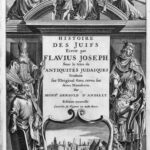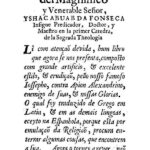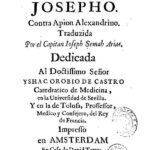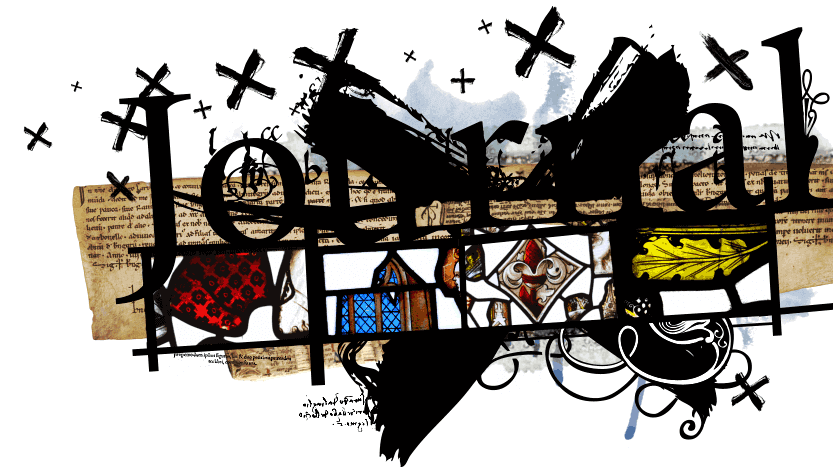Dead Voice, Latent Voices — Weiss
By Julian Weiss | Published on April 7, 2022
Documents
Links
Keywords
Share
My contribution to the Iberian Connections workshop is about the connections that are made between times, places and peoples through the medium of the printed book. It forms part of my ongoing research into the early modern reception of the Jewish historian Flavius Josephus, as he was translated into Castilian for non-professional readers. The title of my project, In the Tracks of Josephus: Translating Jewish History and Belief in Early Modern Iberian Worlds, 1492–1687 indicates its chronological scope. In these two centuries, copies of Castilian translations of Josephus travelled throughout the Hispanic and Lusophone worlds and their contact zones, from Asia (China, the Philippines), through North Africa, Europe to the New World (Mexico, Peru, Surinam, among others). What was the appeal of Josephus for early modern lay readers? How was this ancient Jew translated, and made to speak again, in Spanish and Portuguese worlds that had denied their Semitic past and were continually haunted by it? Textual evidence alone cannot answer these and other questions. The translated word must be read within (and sometimes against) its material means of transmission: the printed book.
My talk is based on translations of Josephus’s Antiquities and the Jewish War, both produced in the 1550s, and both printed by the prolific Flemish printer Martín Nucio (1515–1558). Nucio published in Antwerp so many of the vernacular works we now consider to be a central part of the ‘Spanish’ canon (Juan de Mena’s Laberinto de Fortuna, Celestina, Lazarillo de Tormes, the Romancero…): ‘Spanish’ in quotation marks because, these works, like those of Josephus, had an international readership and owe their existence to an international and transhistorical cultural network.
My case study needs a bibliographical context. I provide it here, in two parts. In the bibliographical list below this article, I summarise the Iberian translations, with basic bibliographical information. To this list I add some primary texts that derive from Josephus and travel in his company, as direct or indirect interlocutors. Second, I offer a few notes on the story that might be woven on the basis of the history of the printings of the ‘Spanish’ Josephus.
A Story (in Draft)
Embedded in the print history summarised below is a story with many threads –– or, rather, many stories, interlaced with multiple threads. The word ’embedded’ raises questions, of course, about the researcher’s relationship to the object of her inquiry. I recognise that as I purport to follow ‘In the tracks of Josephus’ (to borrow the title of my project) in many ways the ‘tracks’ that I am following are my own.
Nonetheless, if I may still speak of ‘facts’, as I review the Iberian corpus from the broad perspective of early modern European vernacular translations (into French, Italian, German, Dutch, etc.) I am struck by the relative modesty of Castilian translations (I avoid the term Spanish for the moment, since Castilian was also a language of Portuguese book culture). From the 1530s onwards, volumes of Josephus’s complete works appeared in French, Italian and German, each with copious reprints and retranslations. No such volume was ever printed within Spanish and Portuguese domains (even in the late XVIIIc, when new Castilian and Portuguese compilations were printed, they failed to include Against Apion). The relatively sparse print history does not signal lack of interest within Iberia, its global domains and contact zones. References and influences abound in a myriad of literary and historiographical genres; scholars such as Benito Arias Montano mined Josephus’s writings; the plans for the Escorial were thought to be based on his description of the Temple of Solomon. Copies in Latin, Spanish, French and Italian were regular items in early modern Spanish and Portuguese private, ecclesiastical and monastic libraries. The 1544 editio princeps, printed in Basel, was dedicated to Diego Hurtado de Mendoza, Charles V’s envoy; it was based on Greek manuscripts that Mendoza himself provided, and was edited by his librarian, the Dutch humanist Arnoldus Arlenius. Josephus travelled across Iberian domains and its contact zones, from the far East, in Hindustan and China, to the New World (it was one of the ‘books of the brave’), where it was read and used in Mexico, Surinam, Peru and elsewhere. Not just Josephus but his avatars too: legends about the destruction of Jerusalem, in the Vindicta Salvatoris tradition, were often dramatised (including in Nahuatl) for exemplary performance; Josippon, the tenth-century Italian Jew whose account of the Jewish War derives from Josephus, became the prime source for Jewish readers well into the early modern period.
The Iberian reception thus has a very distinctive character, with unique features: each volume tells a story of Iberia’s tortured (and torturing) relationship to its Jewish past. The anonymous Catalan translation of the Antiquities, published in Barcelona in 1482, was the very first vernacular translation to have been printed. In 1492, only a few months before the Edict of Expulsion, and shortly after the conquest of Granada, the Royal Chronicler Alfonso de Palencia published a volume combining his translations of The Jewish War and Against Apion. This was another first: it was the only time these texts would ever be coupled in the vernacular. In a recent article, I suggested that this Castilian pairing, like the Catalan Antiquities, was the last remnant of the medieval textual convivencia between Christian, converso and Jewish readers. These ties to the past were cut in 1532, when Juan Cromberger revised Palencia’s translation of the Jewish War, but suppressed Against Apion. At the end of his edition, he declared that Against Apion was not relevant to the destruction of Jerusalem and the fate of the Jews. Cromberger’s note reappears in the reprints of 1536 and 1551, alerting non-Latinate Christian readers to the work’s existence, even as it veiled its actual content. Nucio’s 1554 edition of an anonymous Castilian translation of the Antiquities also includes Josephus’s Life and the spurious De Imperio rationis (On the Sovereignty of Reason), attributed to Josephus since the Church Fathers. Nucio’s compilation is also unique in its combination and arrangement of texts. A mere accident, perhaps, but it invites a particular reading. I shall test it out in my talk.
Only in Spanish and Portuguese domains did the vernacular Antiquities appear on an index of printed books. Thus, shortly after Nucio commissioned a new translation of The Jewish War (Cordero, 1557), the non-Latinate layperson’s official access to vernacular translations was limited to a work that had been absorbed into a Christian vision of Jewish obduracy, factionalism, and Divine punishment. The Castilian Josephus, then, was read under the sign of death –– the death of Jews, and the death of Judaism. The need to continuously repeat this literal and symbolic death seems a dominant feature of the Christian print history. Cordero’s translation of the Jewish War opens with an index of dead Jews for the readers’ ‘maravilla grande y espanto’; MSS indices and marginalia in copies of Palencia’s 1492 translation are further evidence for the fascinated horror of slaughtered Jews. However, Josephus’s writing resists reductive readings. Even the Jewish War contains stories of resistance and transcendence.
Moreover, we must beware of constructing too linear a history of printed books: print and reading histories are not identical. Surviving copies of Palencia’s 1492 volume attest to its continued sixteenth-century use. Though Cromberger had suppressed Josephus’s dazzling defence of Judaism, Against Apion was still available, and being read. Like the book itself, ‘the laws of the Jews live on’ (a comment in one of the most extensively annotated copies). Nonetheless, it was left to Sephardic Jews to reclaim Against Apion, first in Constantinople in 1566, when Samuel Shulam added a Hebrew paraphrase to his edition of Abraham Zacuto’s Book of Genealogies, and then in 1687 when Josefo Semah Arias retranslated it into Castilian via the French. Semah Arias wrote for the Sephardic Jews of Amsterdam, as part of the movement of rejudaization, supported by the printing press of the Portuguese Jew David de Castro Tartas. Again, we have another unique volume in the history of Josephan editions. This is the only time the work was published independently before the twentieth century, and its format and paratexts are eloquent. Divorced from all the critical apparatus that had guided Christian readers of the Latin, Greek and vernacular editions, the volume is a pocket vademecum, a testimony to the endurance of Judaism and the Sephardim themselves.





